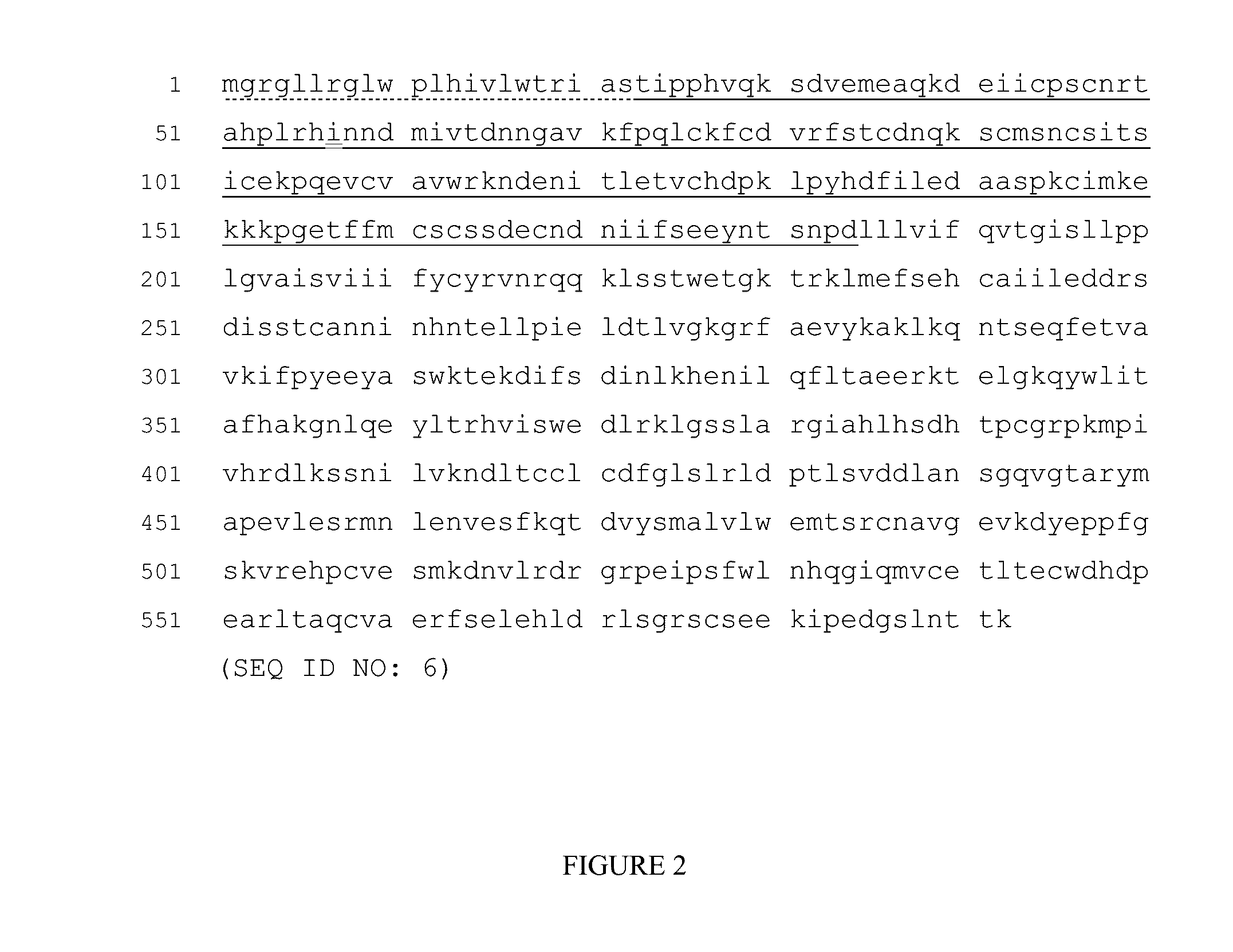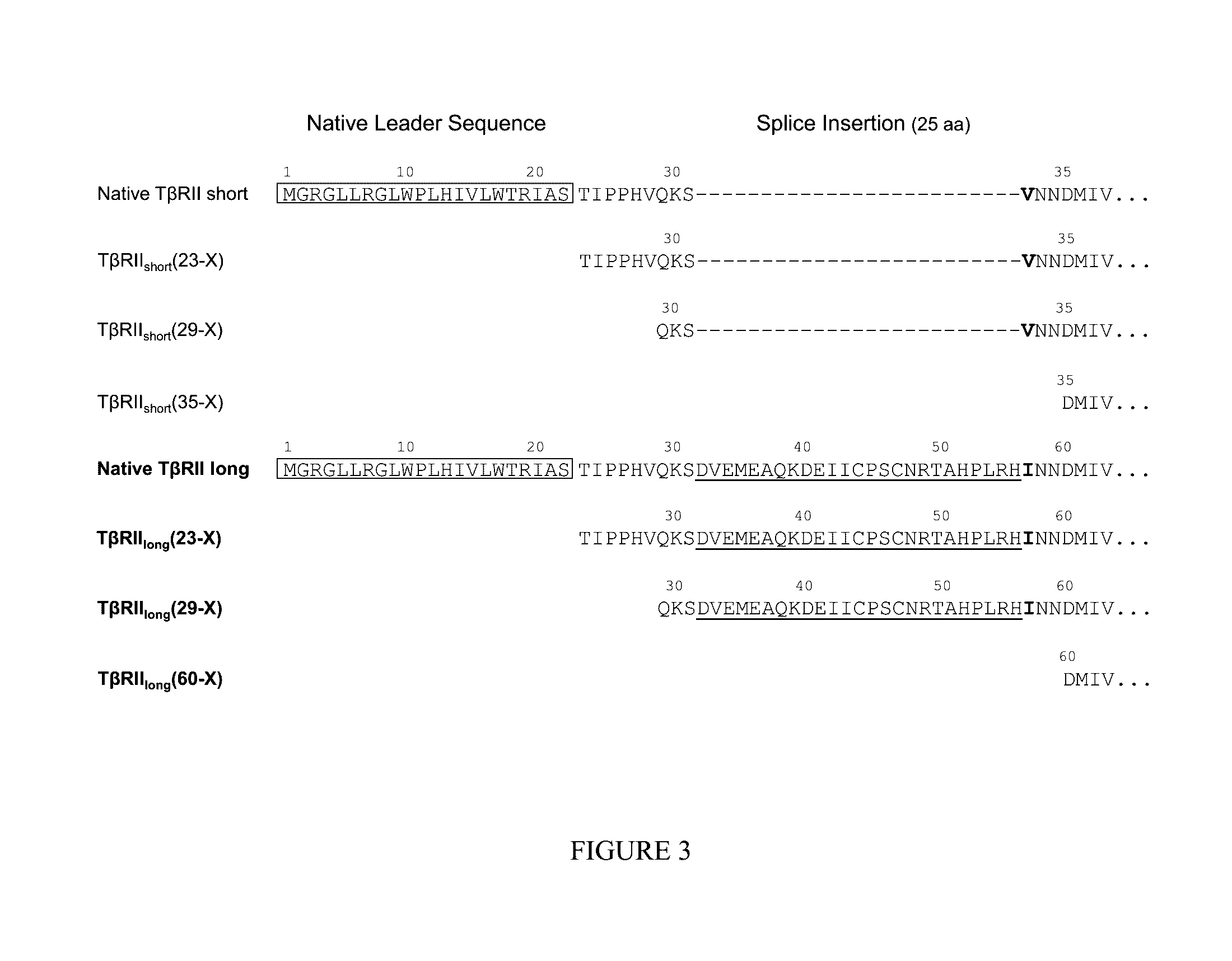Methods for treating myeloproliferative disorders
a technology of myeloproliferative disorders and treatment methods, applied in the field of myeloproliferative disorders, can solve the problems of patient's high risk essential thrombocythemia, and high risk essential thrombocytopenia, and achieve the effects of preventing, reducing the progression rate and/or severity, and high risk of essential thrombocytopenia
- Summary
- Abstract
- Description
- Claims
- Application Information
AI Technical Summary
Benefits of technology
Problems solved by technology
Method used
Image
Examples
example 1
Generation of Receptor Fusion Protein Variants
TβRII ECD Variants
[0279]Human TβRII occurs naturally in at least two isoforms A (long) and B (short) generated by alternative splicing in the extracellular domain (ECD) (FIGS. 1 and 2). TβRII binds with high affinity to TGFβ1 and TGFβ3. While in some therapeutic settings this spectrum of ligand binding may be advantageous, in other settings a more selective molecule may be superior. As detailed below, Applicants generated and have envisioned various TβRII polypeptides and Fc fusion proteins comprising an extracellular domain of the TβRII long or short isoforms (TβRIIlong or TβRIIshort) as well as variants thereof.
[0280]The wild-type hTβRIIlong(23-184) sequence is shown below (SEQ ID NO: 13), in which the 25 amino-acid insertion is underlined. Note that splicing results in a conservative amino acid substitution (Val→Ile) at the flanking position C-terminal to the insertion. Sequence relationships among several hTβRIIshort variants and the...
example 2
Differential Ligand Inhibition by Receptor Fusion Protein Variants in Cell-Based Assay
[0296]A reporter gene assay in A549 cells was used to determine the ability of hTβRII-hFc variants to inhibit activity of TGFβ1, TGFβ2, and TGFβ3. This assay is based on a human lung carcinoma cell line transfected with a pGL3(CAGA)12 reporter plasmid (Dennler et al, 1998, EMBO 17: 3091-3100) as well as a Renilla reporter plasmid (pRLCMV) to control for transfection efficiency. The CAGA motif is present in the promoters of TGFβ-responsive genes (for example, PAI-1), so this vector is of general use for factors signaling through SMAD2 and SMAD3.
[0297]On the first day of the assay, A549 cells (ATCC®: CCL-185™) were distributed in 48-well plates at 6.5×104 cells per well. On the second day, a solution containing 10 pGL3(CAGA)12, 100 ng pRLCMV, 30 μl X-tremeGENE 9 (Roche Applied Science), and 970 μl OptiMEM (Invitrogen) was preincubated for 30 min, then added to Eagle's minimum essential medium (EMEM, ...
example 3
Exemplary hTβRII-hFc Nucleic Acids and Proteins
[0303]This example summarizes nucleic acid constructs that can be used to express TβRII constructs in HEK-293 or CHO cells, according to the methods provided herein in order to provide the proteins isolated from cell culture. In each case the mature protein isolated from cell culture will have the leader sequence (dotted underline in each sequence below) removed.
Item 1 shows the amino acid sequence of hTβRIIshort(23-159 / D110K)-hG2Fc (SEQ ID NO: 25). Double underline indicates D110K substitution. Dotted underline denotes leader, and solid underline denotes linker.
(SEQ ID NO: 25) 1 51QLCKFCDVRF STCDNQKSCM SNCSITSICE KPQEVCVAVW RKNDENITLE101TVCHDPKLPY HKFILEDAAS PKCIMKEKKK PGETFFMCSC SSDECNDNII151FSEEYNTSNP DTGGGVECPP CPAPPVAGPS VFLFPPKPKD TLMISRTPEV201TCVVVDVSHE DPEVQFNWYV DGVEVHNAKT KPREEQFNST FRVVSVLTVV251HQDWLNGKEY KCKVSNKGLP APIEKTISKT KGQPREPQVY TLPPSREEMT301KNQVSLTCLV KGFYPSDIAV EWESNGQPEN NYKTTPPMLD SDGSFFLYSK351LTVDKSRWQQ GNVFSCS...
PUM
| Property | Measurement | Unit |
|---|---|---|
| time | aaaaa | aaaaa |
| temperature | aaaaa | aaaaa |
| temperature | aaaaa | aaaaa |
Abstract
Description
Claims
Application Information
 Login to View More
Login to View More - R&D
- Intellectual Property
- Life Sciences
- Materials
- Tech Scout
- Unparalleled Data Quality
- Higher Quality Content
- 60% Fewer Hallucinations
Browse by: Latest US Patents, China's latest patents, Technical Efficacy Thesaurus, Application Domain, Technology Topic, Popular Technical Reports.
© 2025 PatSnap. All rights reserved.Legal|Privacy policy|Modern Slavery Act Transparency Statement|Sitemap|About US| Contact US: help@patsnap.com



